A Hobby Guide to Growing Tomatoes: Guest Post
My friend Matt sent me this a while ago. And I promptly didn't put it up on the blog. My apologies, but then again, we are just hitting planting season here in the Heart of America, so it is timely for that and northerly climes.
A Hobby Gardeners Guide to Growing Tomatoes
By Matt Crowe
So full disclosure, I’m not an expert on growing tomatoes, nor do I consider this the be all end all of advice. I do however love tomatoes, my favourite fruit, and have been growing them for twenty plus years with varying and steadily improving levels of success. This is simply the culmination of many years of trial and error to find what works best for me, the last several years have been very good.
The guide came about because last year I had several people asking me how I got my tomatoes this big. So whether you’ve been gardening for years, or are just starting out, I hope at least some of this info helps you get bigger and better yields.
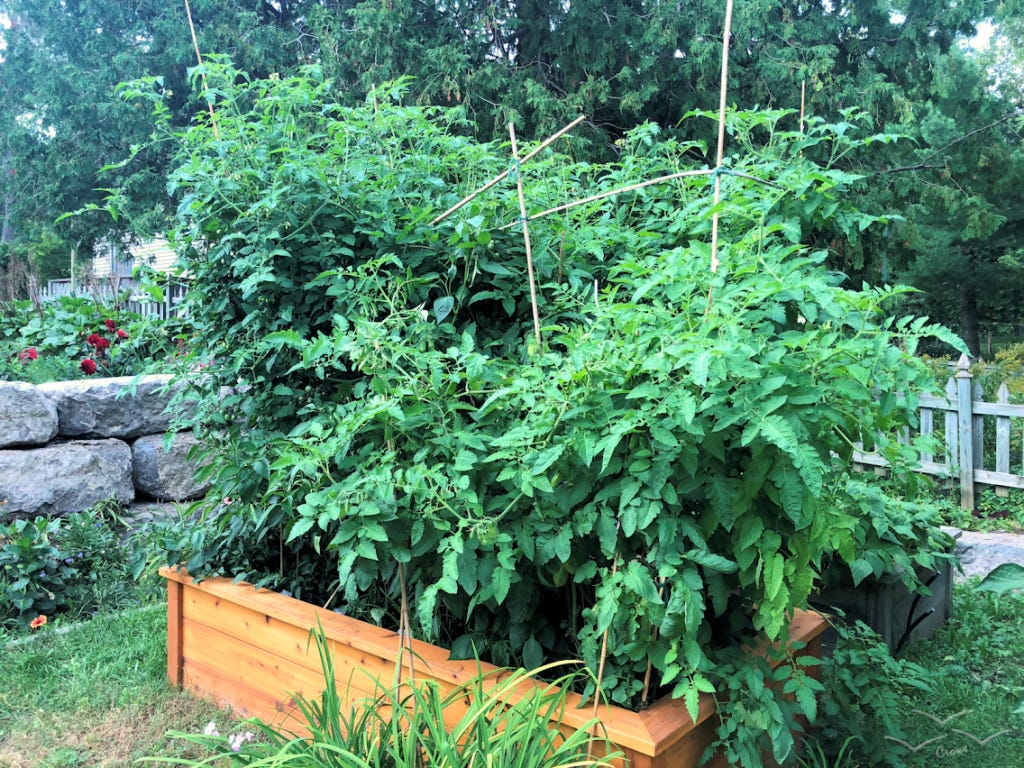
For scale that is a 6 ft ladder, and from the soil those plants were about 8 ft pushing 9 ft tall at their peak growth.
I’m going to break this into two sections, the Too Long, Didn’t Read bullet point version and a very in-depth version.
So TLDR: Here are the top 7 tips. Your mileage may vary.
Location
Location
Location
Soil
Support
Water
Pruning
1.-3. Location is hands down the most critical and bears repeating. Tomatoes need tons of sunlight and they also have to breath. An open area receiving at least 8 hours of sun is best. For those in the southern States, some sort of mid-afternoon shade during peak temperature might help. I don’t live that far south so I couldn’t tell you if it matters or not. (If someone does have experience down there feel free to comment on what you do.) Also, give them space. Tomatoes can get very large and need 2-3 feet between plants for better airflow.
4. You need good rich soil for tomatoes. If your soil is very sandy or heavy in clay, go spend the money and get some good quality garden soil or triple mix. Triple mix is soil, peat, and compost.
5. Tomatoes plants are very delicate. What does that mean? Well the stems on a tomato are not very sturdy. If there is too much weight on it the stem will collapse and you’ll end up with most of your plant on the ground. If you provide good support, either a trellis, pole, or cage (best in my opinion), it will help take the weight of the plant and you will have fewer breaks.
6. Tomatoes love hot weather. The hotter it is the more you need to water, ideally in the morning. Give them a good soaking anytime the soil starts to dry out. Don’t use the surface to check, go down about an inch or two to see if the soil is moist or not. Avoid watering after late afternoon and from overhead. Water near the soil.
7. Don’t be afraid to trim your plants once they get over 2 or 3 feet. It will only help the plant getting rid of diseased leaves and thinning out the bottom as it gets much bigger. Some people swear by removing the suckers as they are usual called. That’s that little tiny shoot growing out from the top of a branch point.
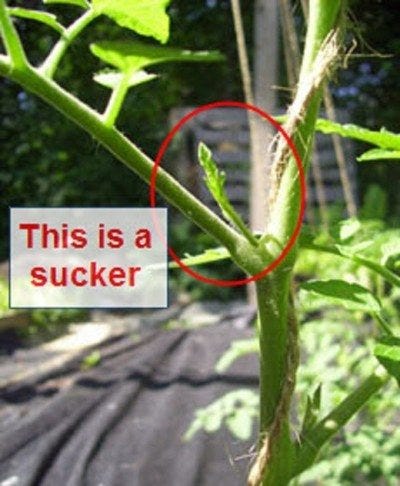
This picture does not belong to me but is free use, the annotations are mine.
I personally haven’t got an opinion either way. I have removed and not without noticing any difference, however after the plants reach a certain size, it just becomes too much work, especially if you have a lot of plants.
That is the distilled version of what I do to get good plants, but the one thing you can’t control is the weather. You could do everything right, but that season just doesn’t cooperate, it’s either too cold, too wet, or too something else, and you end up with a bad harvest. The only condition you can really fix is if it’s too dry or drought like. If you want more information on the tips above and a few other tidbits, simply scroll past the pictures and keep reading.
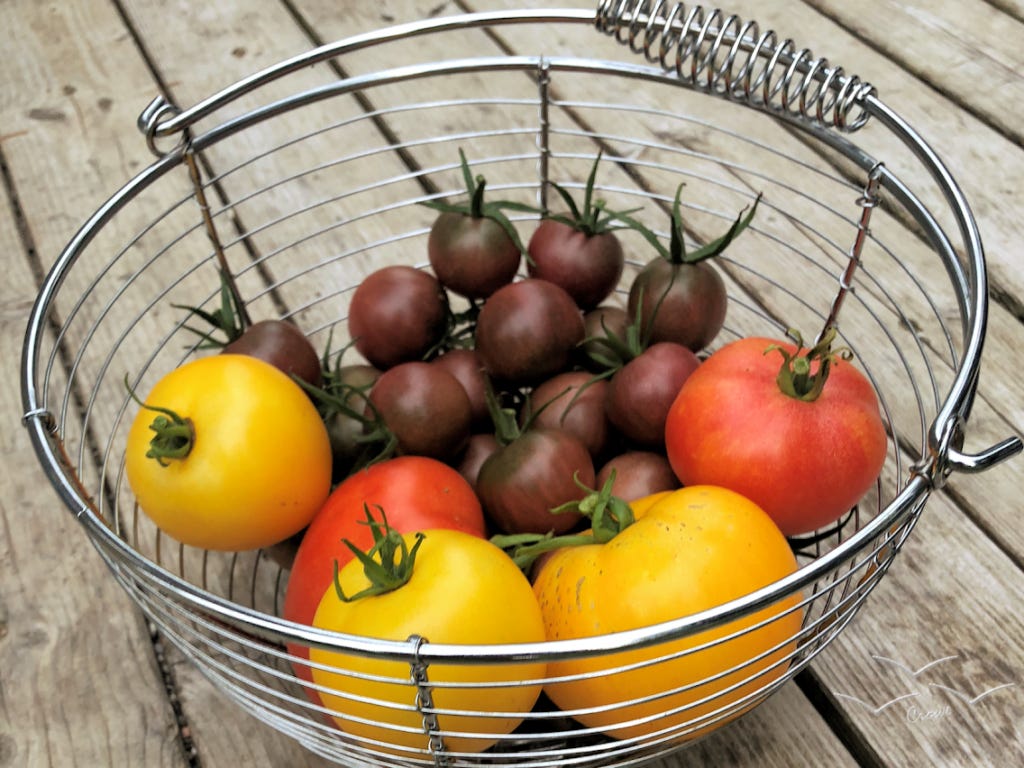
Fresh tomatoes
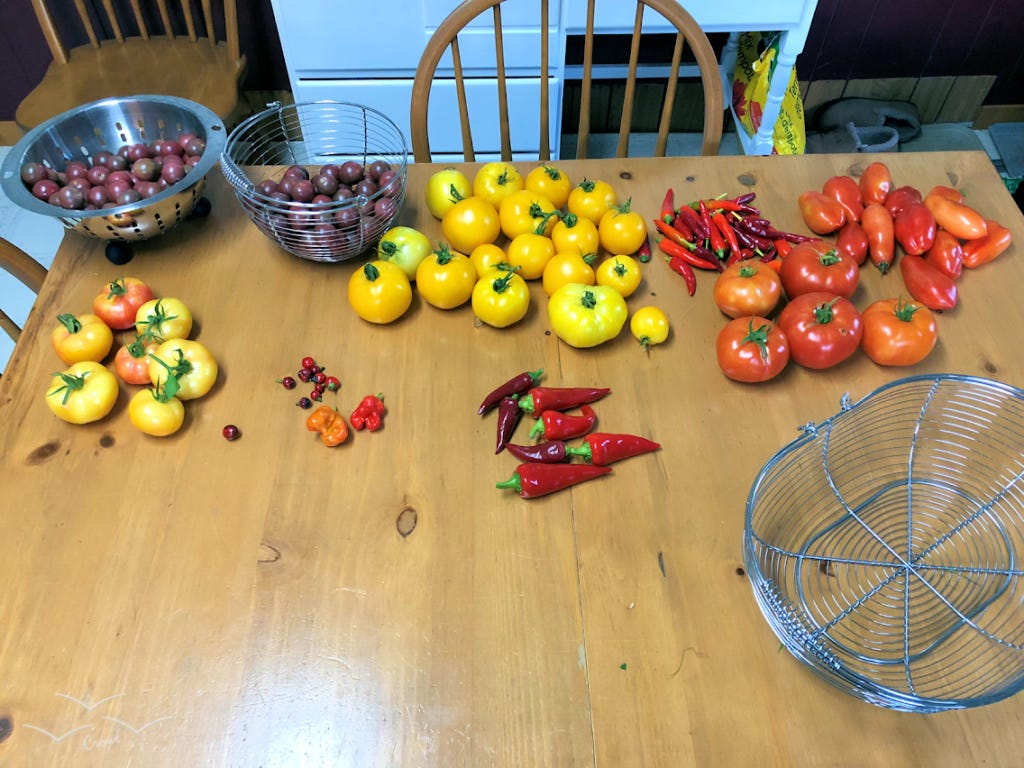
One of the harvests, including peppers.
Here, I will expand upon what I have already mentioned, with methods and information that has helped me.
Location
This is by far the most important. As mentioned above tomatoes love sunlight and heat, and the more the better. I have mine planted in an area that is not quite ideal but it works in the constraints of my yard. They get between 8 and 10 hours of direct sunlight during the peak of summer. Where I live, summer temps average 26°C (80°F) but days over 30°C are pretty common and it’s humid here. The down side of where I plant is that it’s somewhat sheltered for airflow.
Airflow is very important for tomatoes to help keep the stems and leaves dry and disease free. This is one of the reasons why the plants need lots of space. I have to be careful when I’m planting that I don’t put the larger varieties on the sunny side or they will grow faster than the ones behind and shade them out. It’s best to give a single plant 2-3 feet to a side and twice that between rows so that you can walk between them.
If you have the space, make sure to rotate where you plant tomatoes each year. This will greatly help to prevent disease and allow the soil to recover.
Soil
Having good soil is vital to having a healthy plant. If your soil is very poor and/or low in nutrients, it won’t matter what you do, that tomato just won’t grow very well. There are all kinds of kits out there for testing soil to see what needs to be added to balance it out depending on what you’re growing. I won’t get into that here, and will simply recommend doing your research if you want to try that. Amending the soil either with compost or fertilizer, is something that should be done at least every couple years, but every year is better.
If your soil is very dense and doesn’t drain water well, you can try mixing in compost and peat to help loosen it. If your soil is very sandy the same applies however it won’t last forever. For more information on fixing sandy soil check out these links: permanently improve sandy soil, and dirt-dirt-sand.
If you want to go all in and replace your existing soil be aware that this can get quite expensive very quickly. As an example of cost, the two new raised boxes we put in last year each took about 1.7 yards of soil because of their depth, I don’t know exactly because we also used some left-over soil from the last load I got in. The 3 yards I ordered for the boxes cost $46 each.
Getting the Plants
If you’ve started your own or have someone start them for you, then you probably know how to harden them off and plant them. For those who don’t know what hardening is, that is when you take the still tender starter plants, this applies to both home-grown and store-bought starters, and over a week or two, acclimate them to the outdoor conditions by leaving them outside in the shade for a few hours a day to start. Each day you leave the plants out a bit longer and start adding sun and rain. If they came from a store then you can probably skip right to gradually increasing the sunlight.
If you can’t start your own or you don’t have someone to do it for you, no problem. While this is the best way to get your plants, as you know exactly what you are getting, it doesn’t work for everyone. Store bought plants are fine as long as you keep in mind the selection can be more limited, and the quality may not be the greatest. If you have a permanent garden center or nursery local to you, that is a good second choice, they should know what they’re talking about if you need help. The size of the plant helps too. The bigger the plant you start with the sooner you can start harvesting, this is much more important in the northern climates, such as where I live. I’m in Eastern Ontario and our growing season is about four and a half months in a good year, usually more like four. The bigger the starter I put in the ground the less time it takes to properly establish itself before beginning its full growth. If your season is short like mine, it’s worth paying more for a larger plant. I recommend something in the 18-24” range. Keep in mind, having more soil in the pot you buy does not mean a better plant. You can get an 18” plant in a 4” pot and it’s a lot cheaper than that same plant in a 10” pot, you are simply going to pay a premium for the extra dirt in the bigger pot.
Planting
Ok, you have the location, you prepped the soil, and you have your plants ready to go in the ground, what now?
No matter where your plants came from, planting is the same. The thing to remember with tomatoes, and to some extent peppers, is: the deeper you plant them, the better and deeper their root base will grow. All those little hairs on the stems are potential roots. I prefer to pick off any leaflets from the main stem(s) below the 12” mark on the plant a day before I plant it. A co-worker friend doesn’t see the need and is quite happy with their yield, so who knows. If you do pick off the bottom leaves you really do need to leave it for a day before you bury it so the wounds can seal over.
When you are ready to plant them, dig a hole at least half as deep as the plant is tall, including the pot. I tend to go about 12” regardless, but if my starter is so tall that this isn’t even half then I just dig the hole wider and slope one side to help support the plant when I start covering it. If you have Epsom salts sprinkle a spoonful into the bottom of the hole and mix it in. This isn’t necessary but it can’t hurt. I would have liked to show a picture of what it looks like, but I was never expecting to be writing a guide like this. Cover the tomato and firmly press the soil down before giving it a through soaking. Do not use fertilizer on a newly transplanted plant or you can end up damaging it.
Support
Tomatoes are vines and will happily grow higher as long as you provide support for them. Some of how they grow depends on what type they are. Beefsteak, Early Girl, almost any Cherry variety, and many other common round tomatoes, are all indeterminate or vine tomatoes. They will continue growing and bearing fruit as long as the weather is warm enough. Determinates are more the plum tomatoes, tend to be less vine like and will be bushier, not growing as high normally. These will usually ripen all their fruit over the course of a week or two depending on the plant. While I grow both, I treat them all the same as far as support.
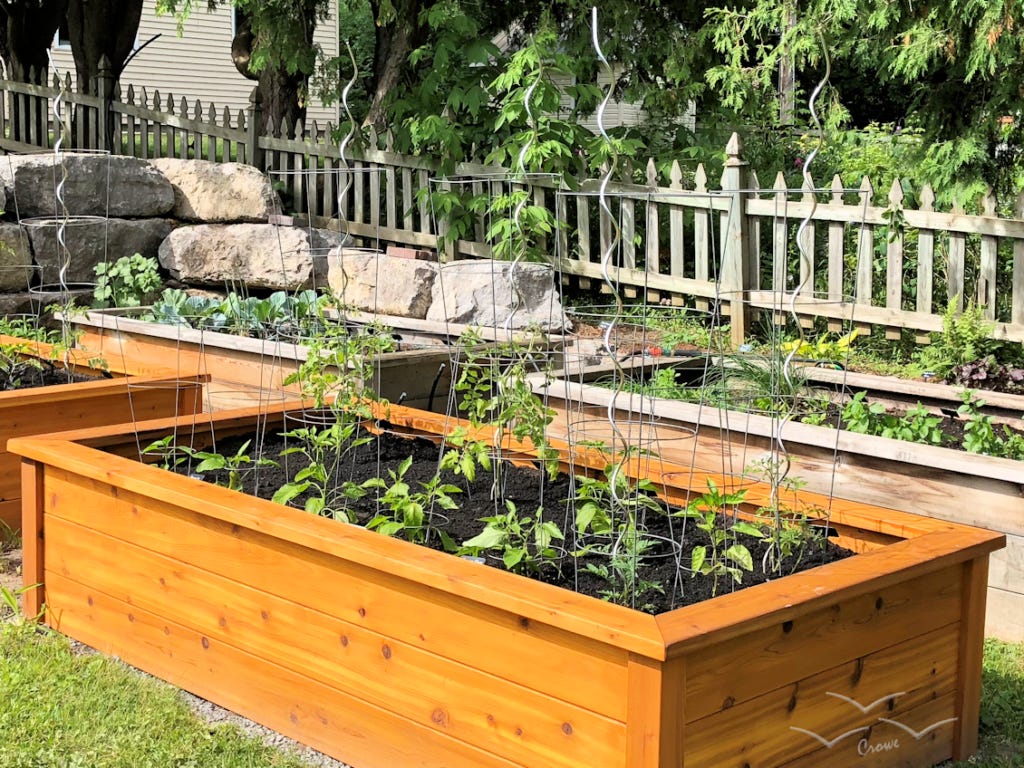
If you don’t have any, or all you have are short thin wire cages, go get yourself some heavy or thick gage tomato cages, to me these are hands down, the best single method out there for supporting your plants. The heaver wire can handle larger plants before starting to tip over under the weight. I use 4’ heavy gage cages to support the off shoots in combination with a 6’ spiral pole in the center of the cage to support the main stem. This technique has consistently produced the best results for me, though the last couple years I’ve had to add in additional support through the season because of the sheer size and weight of the plants. Remember the first picture? This year I hope to build a more permanent layered trellis solution for mid to late season growth. In the beginning and until you find out how large your plants will get, I would stick with the cage and pole.
Insert the pole right up against the main stem of the plant being careful not to damage the portion you buried. Carefully place the cage over the plant and make sure the base of both the cage and pole is in deep enough to hold itself upright with a bit of weight on it. As the plants grow, train them on or around the pole and lightly tie the main stem and larger branches to the supports. If you tie them too tight, then as the stems grow bigger it will choke them off. Even partly broken stems can still be supported and continue to grow healthy tomatoes past the break, but if it starts to wilt remove it.
This is a couple weeks after planting.
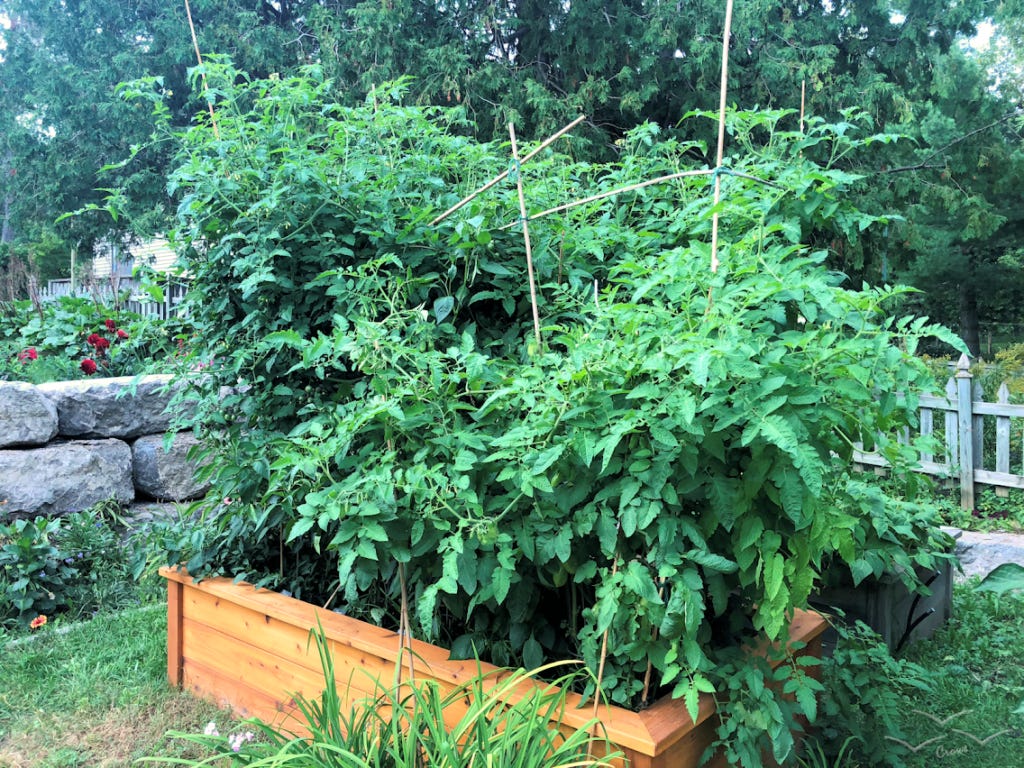
Mid July, call it 6 weeks. They showed all signs of out-growing the cages, so I added more supports.
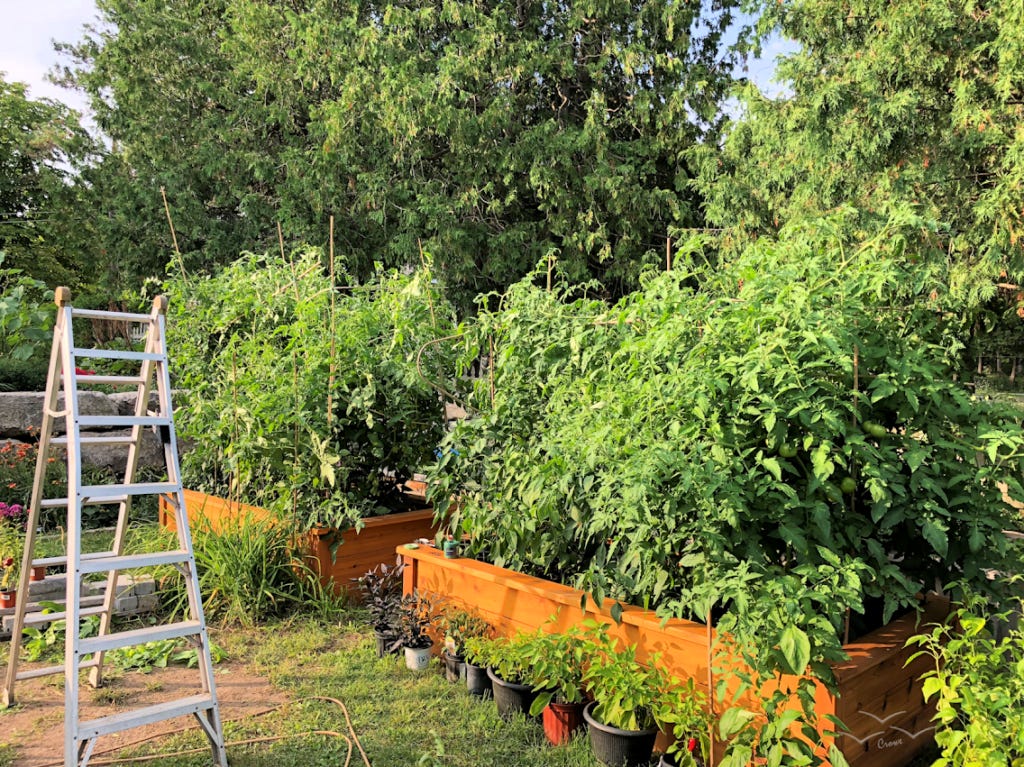
Early September. Several of the bamboo supports I’d added, and the stems tied to them, have broken after a wind storm.
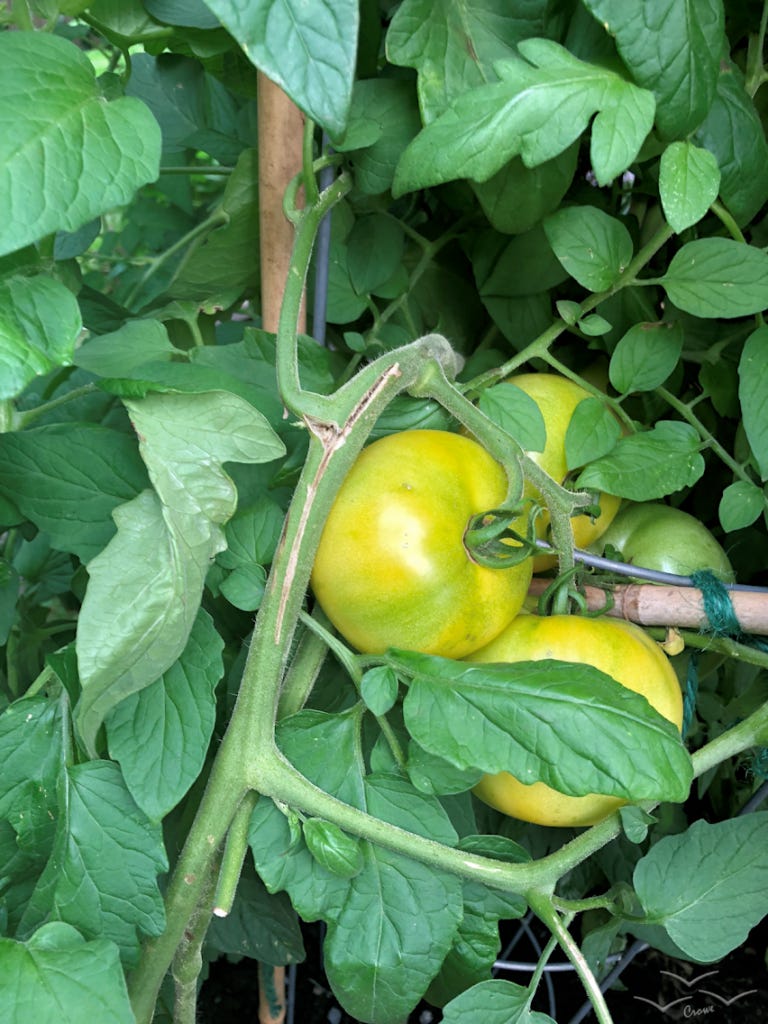
A split stem still producing great tomatoes.
Water
How you water can be just as important as how much you water.
Tomatoes need lots of water to handle the heat. When they are small you really need to watch that the soil doesn’t dry out too much or your plants will wilt. When they get bigger they need more water to support their size. Most any resource you look at for information will tell you to water 1-2 inches a week, whatever that means. :)
So how much? I’ll use a gallon can simply as a point of reference here.
At the beginning, one can will do about four plants each day. Check the soil an inch or two deep, a bit away from the plants, before starting to water.
Is it dry? You need a good soaking.
Is it damp or slightly moist? Give it a drink to get water down deeper, but don’t drown them!
Is it very moist or saturated? Check again tomorrow.
As the tomatoes grow their thirst will increase. When they get to be 2 or 3 feet, a can might only do three plants, and when they hit 5 or 6 feet, a can will do for maybe two plants.
How do you water?
Preferably in the morning. This will give the plants the moisture for the day and it will allow the leaves to dry on the surface. Try to keep your watering to near soil level. This minimizes splashing and helps keep the soil off the plant. If you do use a sprinkler, avoid watering in the evenings when the temperature starts to dip. The leaves can’t properly dry and you greatly increase the chances of getting blight on your plants, at least in more northern climes. Water not on the plants but around them, and fewer heavy waterings are preferable to many light shallow waterings. Tomatoes tend towards shallow root systems, so the deeper you can get them following the water, the stronger the plant will be. This is also why you want to start the tomatoes as deep as you can when transplanting. When my tomatoes get big enough, they will start to shade their soil and help retain the moisture in the ground. You can also mulch around the plants to help retain moisture, but if you do keep it back from the stems.
Pruning and Blight aka funguses
When done properly, pruning will help your tomatoes stay healthy and encourage more growth. Number one tip for pruning is avoid doing it if you are expecting rain that day, the wounds need time to heal and seal themselves up before getting soil splashed on them. Use a good set of garden shears and never compost any part of the plant. Dispose of it with your yard waste if you have a municipal program for that or burn it.
Once the tomatoes have reached at least a couple feet in height, they should be hardy enough to handle a bit of trimming. Start by removing the lowest leaf branches if they are laying on or very near to the ground, these can’t properly dry out, get soil splashed on them, and will be one of the first places blight or fungus develop if you get it.
As the plant grows you want to keep checking for leaves near the ground and get rid of them. Check for spotted or discoloured leaves as well. The earlier these are seen and removed, the better your chances to keep the plant healthy. If it is just a couple spots on a leave or two, you can just pinch off the individual leaves, but if it is showing on many leaves of the same branch or leaflet it’s best to remove the whole thing back near the stem. In the second image below, I decided to remove the whole leaflet because of the advanced stage of the few spots that were there. There was a good chance the bight had already spread to the adjacent leaves. If you cut any suspect or infected leaves wash or wipe your tools between cuts to help keep it from spreading.
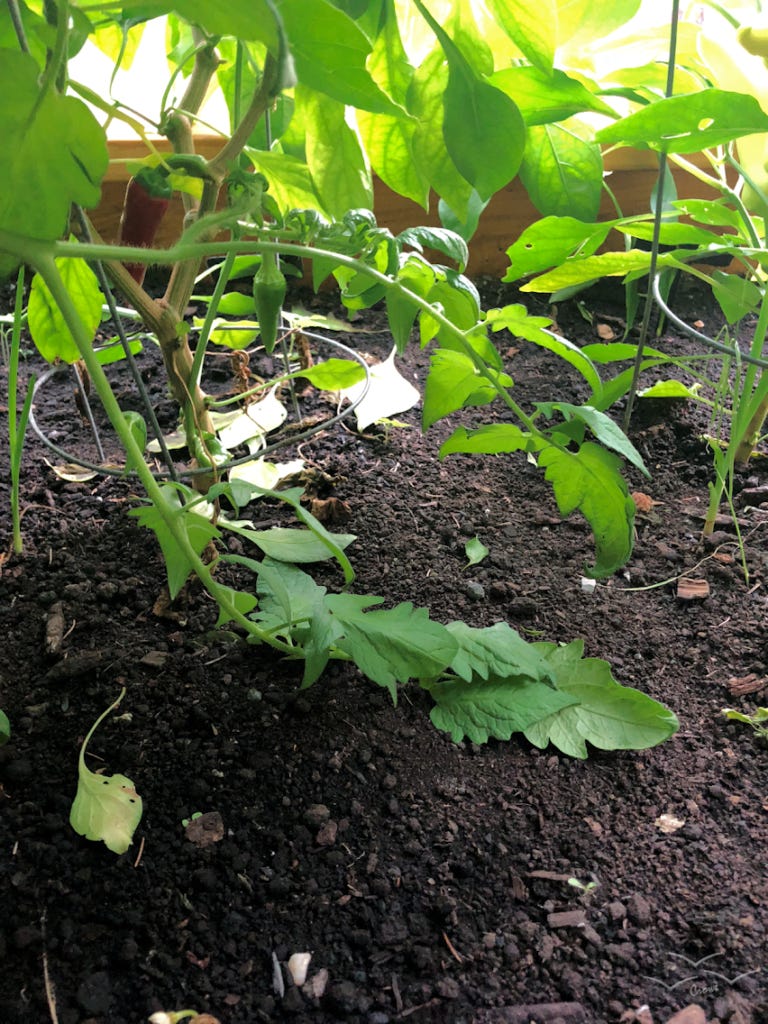
These are the leaflets you want to remove first. They will stay damp this close to the ground.
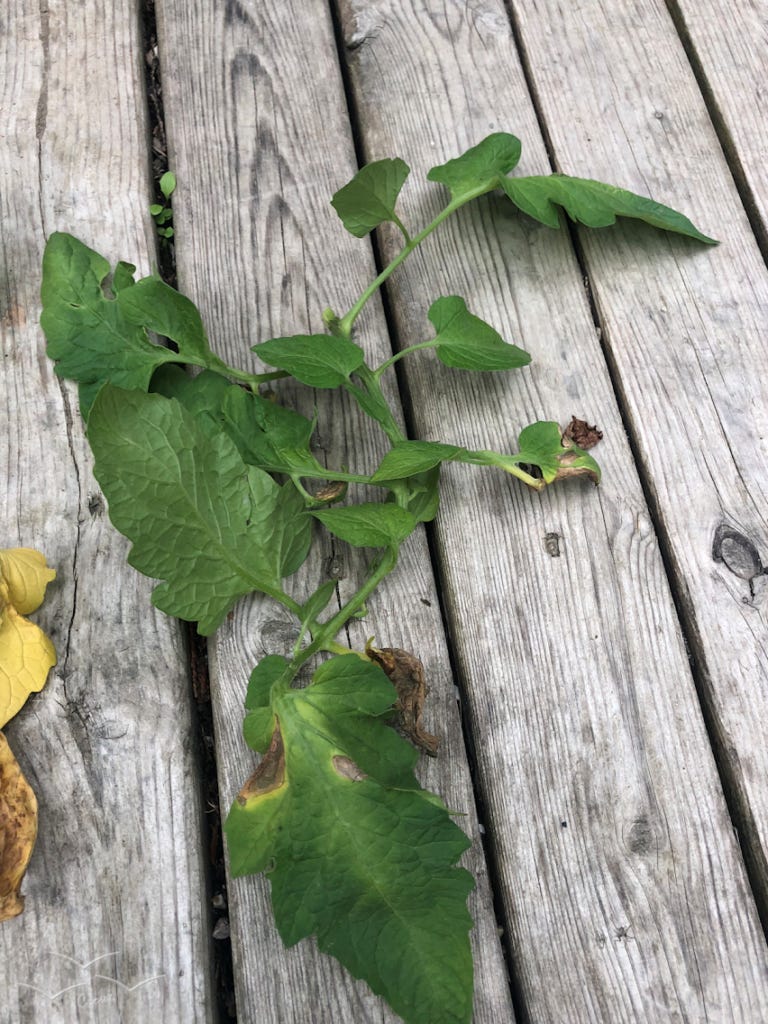
One of the most common forms of blight in its early stages. Note the dead and wilting spots on the leaves.
Advanced blight. This requires more aggressive pruning to curtail, however there is really no way to get rid of it completely at this stage. You can only minimize and manage the spread.
The bigger it gets the more you will need to prune. Thin out the leaves where they rest flat on top of each other or where they are getting thick and continue trimming the bottom until you have a good 12-18 inches of clear space under your plants. Don’t trim too much of the plant at once. No more than a third of the plant is the gardening rule of thumb. Use your judgement on what to get rid of. You’ll soon learn what works and what doesn’t.
As the season wears on and nights start getting cooler, the dew increases the chance of blight and you need to continue thinning the leaves to keep the air circulating. This doesn’t mean you near to be able to see though the whole plant just that you want to keep looking for matting leaves and discolorations in the later season.
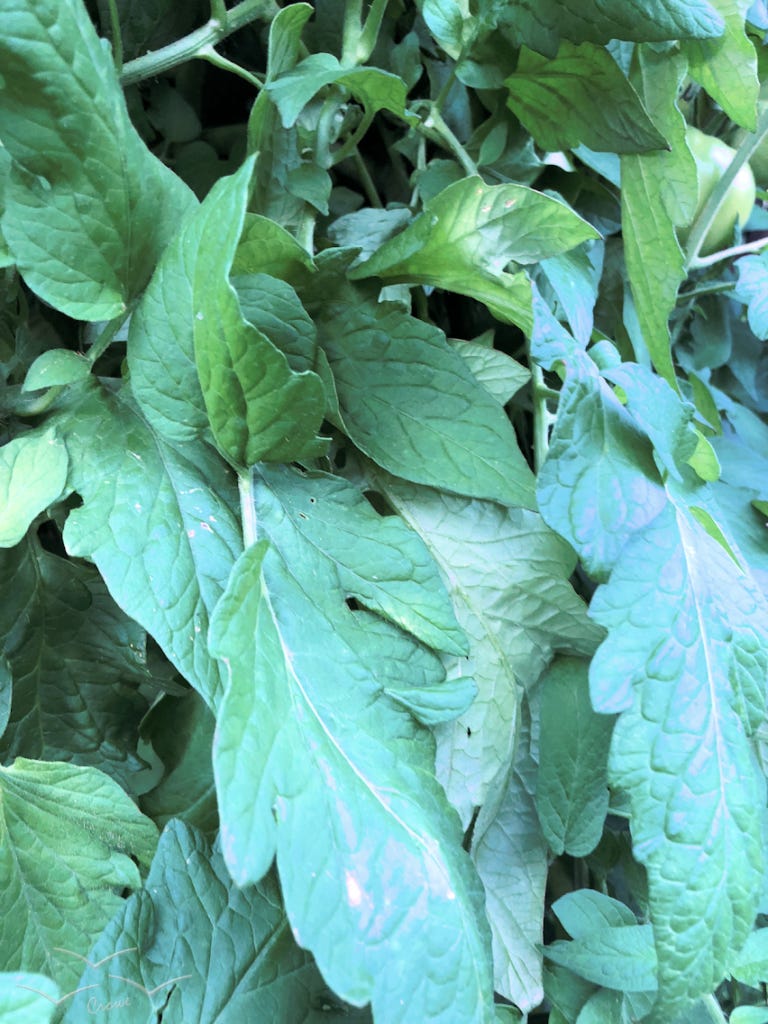
An example of too many leaves on top of each other.
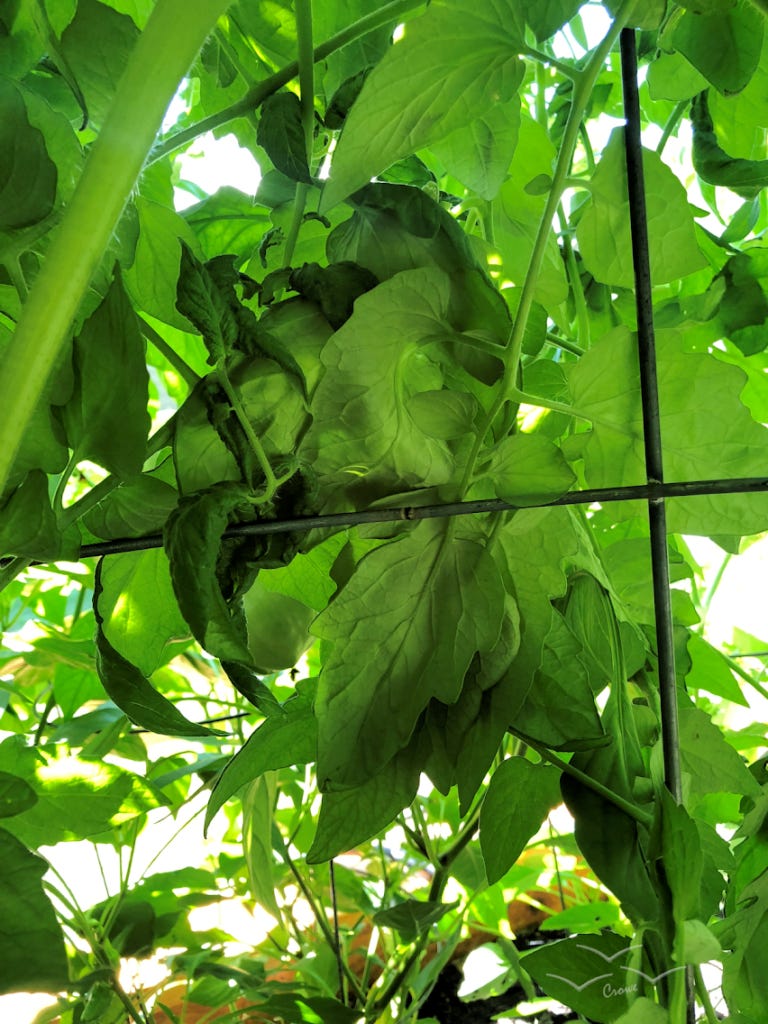
An area that needs thinning to improve airflow.

This is what you want to see around the base of the plants when they get large enough. This has been trimmed up the stem about 18 inches for good airflow around the base.
If you want more information on pruning, or blight.
At the end of the season, before the ground freezes, remove anything left of the tomatoes and again, never compost them at home.
That’s pretty much all I’ve got, all my ‘secrets’ as it were. Thanks for sticking it out. Give some of these a try and see if it makes a difference. There are tons of sites out there with more information if you go looking, do your research. Trial and error are the best ways to learn and earn that green thumb.
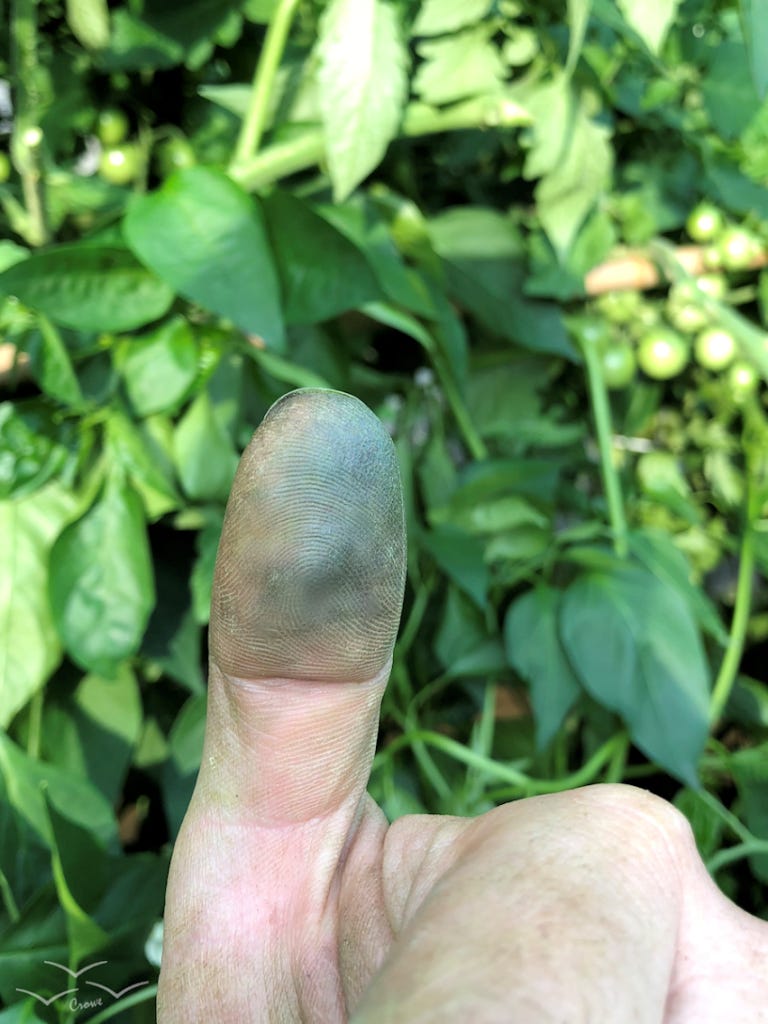
P.S. Tomato plant stains take several good rounds of scrubbing to remove. ;)
All pictures except as noted belong to me. Please do not copy or reproduce in whole or in part without my express written permission. (Cedar's note: if any are out of order it's all my fault).




